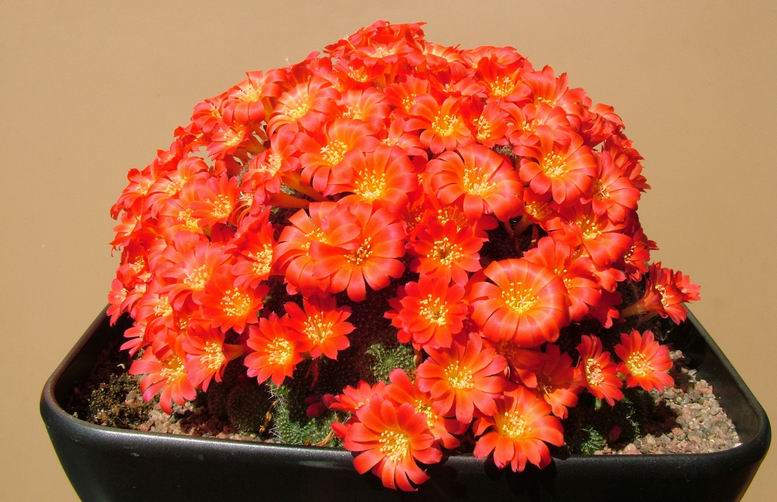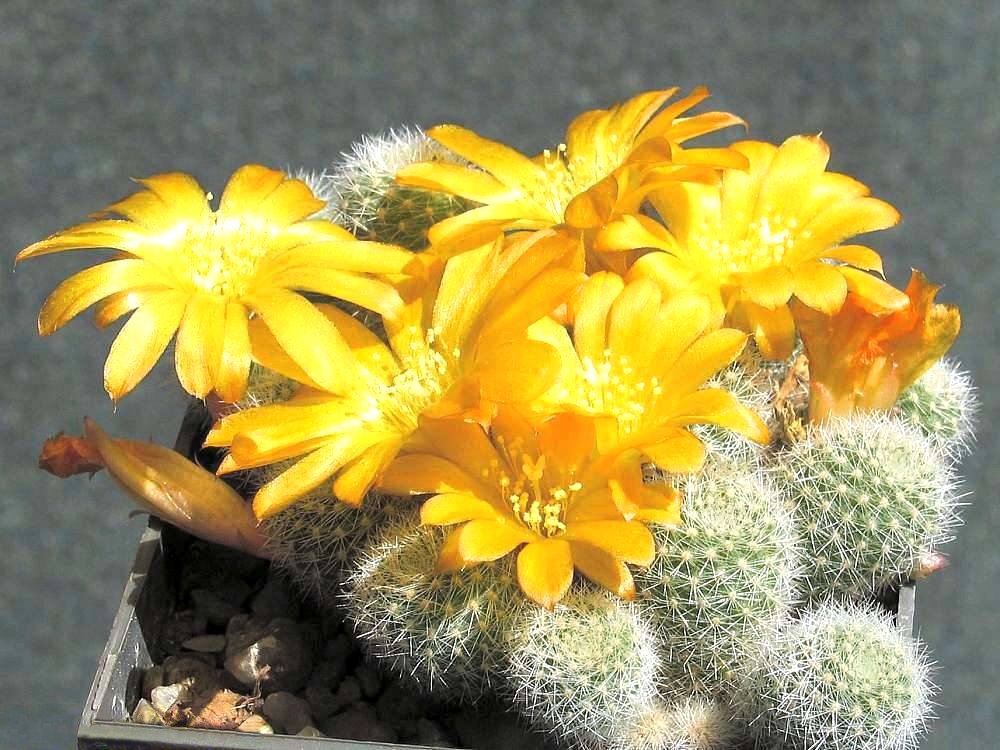|
Aylosterinae
''Aylostera'', is a genus of cactus, native to central Bolivia and north western Argentina. ''Aylostera'' was formerly sunk into a broadly circumscribed genus ''Rebutia'', but molecular phylogenetic studies from 2007 onwards showed that when defined in this way, ''Rebutia'' was not monophyletic, leading to the resurrection of ''Aylostera''. A 2023 classification of the tribe Cereeae placed it as the only genus in the subtribe Aylosterinae. It was formerly placed in the subtribe Rebutiinae. Description ''Aylostera'' species are small cacti with globular stems. The stems may or may not have ribs; this feature can vary even within a species. Their flowers are of various colours. A key feature that distinguishes ''Aylostera'' from ''Rebutia'' is that the pericarpels and receptacles (which together form a structure that is often referred to as the 'flower tube') are hairy, rather than glabrous. Taxonomy The genus ''Aylostera'' was erected by Carlo Luigi Spegazzini in 1923. A histori ... [...More Info...] [...Related Items...] OR: [Wikipedia] [Google] [Baidu] |
Cereeae
Cereeae is a tribe of cacti belonging to the subfamily Cactoideae containing about 50 genera, divided in 2023 among six subtribes. Description Cereeae are tree-like or shrubby, sometimes climbing plants. Their mostly elongated to spherical, ribbed and thorny shoots are not articulated. The flowers, which usually appear on the side of the shoot, open during the day or at night. Their pericarpels usually have a few scales or are completely glabrous. The fleshy, berry-like, bursting or non-bursting fruits often have a blackening adherent flower remnant. The small to large seeds are oval. The hilum and micropyle of the seeds are fused, one appendage is absent. Taxonomy Phylogeny In classifications before the use of molecular phylogenetic methods, Cereeae was one of nine tribes into which the subfamily Cactoideae was divided. Molecular studies found that these traditional tribes were not monophyletic. A broader circumscription of Cereeae, including Browningieae and Trichocereeae and ... [...More Info...] [...Related Items...] OR: [Wikipedia] [Google] [Baidu] |
Rebutiinae
The Rebutiinae are a subtribe of cactus, cacti belonging to the subfamily Cactoideae, tribe Cereeae. A 2010 classification accepted seven or eight genera, but when Circumscription (taxonomy), circumscribed in this way, the subtribe was not Monophyly, monophyletic. A 2023 classification reduced Rebutiinae to three genera. Description Rebutiinae are large tree-like or shrubby plants. Their columnar shoots are articulated or not articulated. The ribs are usually heavily spined. The medium to large flowers appearing on the side usually open at night. Their pericarpel has imbricated scales. The areoles have thorns or bristles. The fleshy fruits are not bursting, scaly, thorned or glabrous. The medium-sized to large seeds are often wrinkled. The hilum and micropyle of the seeds are fused, an appendage is absent, and a mucous sheath is sometimes present. Taxonomy In a 2010 classification of the tribe Cereeae, the subtribe Rebutiinae comprised seven or eight genera, depending on whether ... [...More Info...] [...Related Items...] OR: [Wikipedia] [Google] [Baidu] |
Aylostera Einsteinii
''Aylostera'', is a genus of cactus, native to central Bolivia and north western Argentina. ''Aylostera'' was formerly sunk into a broadly circumscribed genus ''Rebutia'', but molecular phylogenetic studies from 2007 onwards showed that when defined in this way, ''Rebutia'' was not monophyletic, leading to the resurrection of ''Aylostera''. A 2023 classification of the tribe Cereeae placed it as the only genus in the subtribe Aylosterinae. It was formerly placed in the subtribe Rebutiinae. Description ''Aylostera'' species are small cacti with globular stems. The stems may or may not have ribs; this feature can vary even within a species. Their flowers are of various colours. A key feature that distinguishes ''Aylostera'' from ''Rebutia'' is that the pericarpels and receptacles (which together form a structure that is often referred to as the 'flower tube') are hairy, rather than glabrous. Taxonomy The genus ''Aylostera'' was erected by Carlo Luigi Spegazzini in 1923. A histori ... [...More Info...] [...Related Items...] OR: [Wikipedia] [Google] [Baidu] |
Aylostera Deminuta
''Aylostera'', is a genus of cactus, native to central Bolivia and north western Argentina. ''Aylostera'' was formerly sunk into a broadly Circumscription (taxonomy), circumscribed genus ''Rebutia'', but Molecular phylogenetics, molecular phylogenetic studies from 2007 onwards showed that when defined in this way, ''Rebutia'' was not Monophyly, monophyletic, leading to the resurrection of ''Aylostera''. A 2023 classification of the tribe Cereeae placed it as the only genus in the subtribe Aylosterinae. It was formerly placed in the subtribe Rebutiinae. Description ''Aylostera'' species are small cacti with globular stems. The stems may or may not have ribs; this feature can vary even within a species. Their flowers are of various colours. A key feature that distinguishes ''Aylostera'' from ''Rebutia'' is that the Hypanthium, pericarpels and Receptacle (botany), receptacles (which together form a structure that is often referred to as the 'flower tube') are hairy, rather than Glabr ... [...More Info...] [...Related Items...] OR: [Wikipedia] [Google] [Baidu] |
Rebutia Einsteinii 1
''Rebutia'' is a genus of flowering plants in the family cactus, Cactaceae, native to Bolivia and Argentina. The limits of the genus have varied widely, depending on whether genera such as ''Aylostera'' and ''Weingartia'' are included or treated separately. , Plants of the World Online accepted only three species of ''Rebutia''. A very large number of plants that have been treated in cultivation as species of ''Rebutia'' are now generally regarded as varieties, forms or synonyms of a much smaller number of species, or have been transferred to other genera. Plants treated as ''Rebutia'' are generally small, colorful cacti, globular in form, which freely produce flowers that are relatively large in relation to the body. They have no distinctive ribs, but do have regularly arranged small tubercles. They are considered fairly easy to grow and they may produce large quantities of seeds that germinate freely around the parent plant. Taxonomy The genus was designated in 1895 by Karl Mor ... [...More Info...] [...Related Items...] OR: [Wikipedia] [Google] [Baidu] |
Carlo Luigi Spegazzini
Carlo Luigi Spegazzini, in Spanish Carlos Luis Spegazzini (20 April 1858 – 1 July 1926), was an Italian-born Argentinian botanist and mycologist. On the 1881/1882 expedition led by Giacomo Bove to explore Patagonia and Tierra del Fuego, the Italian Decio Vinciguerra was officially both zoologist and botanist, but in fact Spegazzini handled the botanical work. Spegazzini published about 100 scientific papers on vascular plants, describing around 1000 new taxa. He was a professor at the University of La Plata and Buenos Aires in Argentina, curator of the herbarium of the National Department of Agriculture, first head of the herbarium of Museo de la Plata, and founder of an arboretum and an institute of mycology in La Plata city. He issued two exsiccatae, the first series in 1879 with the title ''Decades mycologicae Italicae'' distributing fungi from Italy, the second in 1881 with the title ''Hongos Sud-Americanos: decades mycologiae Argentinae'' distributing fungal spec ... [...More Info...] [...Related Items...] OR: [Wikipedia] [Google] [Baidu] |
Rebutia Fiebrigii 1
''Rebutia'' is a genus of flowering plants in the family Cactaceae, native to Bolivia and Argentina. The limits of the genus have varied widely, depending on whether genera such as ''Aylostera'' and ''Weingartia'' are included or treated separately. , Plants of the World Online accepted only three species of ''Rebutia''. A very large number of plants that have been treated in cultivation as species of ''Rebutia'' are now generally regarded as varieties, forms or synonyms of a much smaller number of species, or have been transferred to other genera. Plants treated as ''Rebutia'' are generally small, colorful cacti, globular in form, which freely produce flowers that are relatively large in relation to the body. They have no distinctive ribs, but do have regularly arranged small tubercles. They are considered fairly easy to grow and they may produce large quantities of seeds that germinate freely around the parent plant. Taxonomy The genus was designated in 1895 by Karl Moritz Schu ... [...More Info...] [...Related Items...] OR: [Wikipedia] [Google] [Baidu] |




